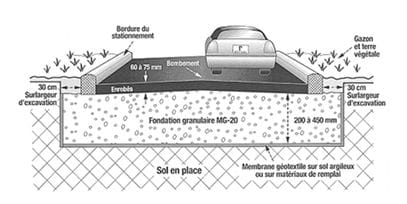EXPERT ADVICE
EXPERT ADVICE FROM LE ROY DU PAVAGE
Our team at Le Roy du Pavage is glad to answer any and all questions you may have about our asphalting and paving services in the Laurentians and the Lanaudière region. On this page you will find information about our work as well as useful maintenance advice and tips. Call us for more information!
AFTER PAVING - HOW TO PROTECT YOUR ASPHALT
Wait at least 48 hours before circulating on the paved surface with your vehicle. For the first year, care should be taken to avoid the passage of heavy vehicles, as well as heavy objects such as motorcycle kickstands, trailer or caravan jacks, and lawn chairs or BBQs which could damage the surface, especially in hot sunny weather. It is also recommended to avoid turning your vehicle's wheels when it is immobilised on the pavement. Finally, wait 90 days before applying a sealer.
ASPHALTING A RESIDENTIAL DRIVEWAY
FIRST STEPS
By performing a soil analysis we can provide you with an accurate estimate of the cost of the project. This also helps prevent problematic situations with regards to draining and the presence of clay or other contaminants. After a visual examination, our specialist will take soil samples in order to obtain an adequate picture of the foundations. For a new construction we wait 6 to 12 months before paving to give the ground time to stabilize.
EXCAVATING, GEOTEXTILE MEMBRANE AND BACKFILL
It is necessary to excavate two to three feet below the surface in order to create a solid base of gravel. The depth varies according to the properties of the soil. For clay soils, we recommend installing a geotextile membrane to avoid contaminating the materials. It is also recommended to backfill the surface in order to prevent frost heaving.
The granular mixture most often used is MG819-326-1630 to 112 mm) to which is added gravel ranging from 0 to 20 mm in diameter. This aids with draining and solidifying the surface.
LAYING THE ASPHALT
The finer the aggregate, the smoother the finish, but it will be fragile. We generally suggest striking a balance between durability and aesthetics. To obtain a thickness of 50 mm after compaction, the layer of asphalt should be 60 to 75 mm thick beforehand.
COMPACTION
The materials are compacted in successive layers, which helps minimize the space between particles as well as water infiltrations that could damage the asphalt during freeze-thaw cycles.



